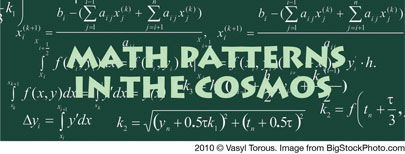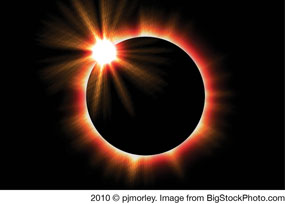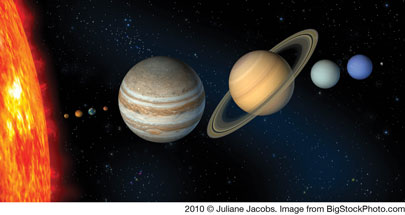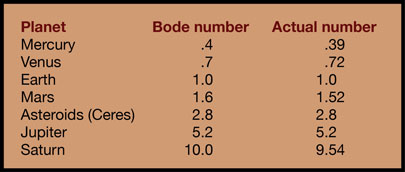
As you admire the sky on a dark winter night, you have two choices
about the origin of what you are observing. You can believe it is all a
part of a great accident that scattered galaxies, stars, planets,
moons, and a variety of other objects across space. Or you can believe
that an intelligence created the cosmos with purpose and conscious
design. Both views have their problems and questions. The idea that the
cosmos is an accident does not explain anything about the origin of
time, space, and/or energy. Suggesting that these things have always
been is at odds with scientific law. The suggestion the cosmos is a
product of intelligence and design raises questions about those things
which seem to be poorly designed or destructive in nature.
For those of us who wish to carefully and thoughtfully consider these
options, it is interesting that the creation is full of math patterns.
Some of these have just been discovered and many of which are not
understood even though they have been recognized for many centuries. In
1702 a Scottish astronomer, David Gregory, saw a pattern in the solar
system that was later popularized by Johann Bode and is called Bode’s
law. Take a series of numbers starting with zero and three and double
each number. That would be 0, 3, 6, 12, 24, 48, 96, 192, … . Now take
each number and add 4 to it and divide by 10. The result would be .4,
.7, 1.0, 1.6, 2.8, 5.2, 10.0, and 19.6. That last set of numbers is the
location of the planets around the Sun in terms of the earth’s distance
from the Sun. Here are the actual numbers:
This turned out to have predictive value. Bode popularized his law in
1768, but Saturn was the last known planet at that time. The next
number after 10.0 in the Bodes Series would be 19.6. Years later
William Herschel discovered Uranus and its distance is 19.2. Things
break down at this point, with Neptune discovered in 1846 not matching
the pattern. Modern astronomers think that orbital resonances and
planets interfering with each other may account for some of the Bode’s
law numbers, but no one really knows at this time why the pattern is
there.
 There are other patterns like this. One we all know
about, at least in
a general way, is the fact that the Moon is 400 times smaller than the
Sun and it is also 400 times closer to us than the Sun, making them
appear to be the same size. That also allows solar eclipses in which
the Moon exactly covers the Sun giving the spectacular “diamond ring
effect” and “halo effect” we see in the wonderful pictures of eclipses.
There are other patterns like this. One we all know
about, at least in
a general way, is the fact that the Moon is 400 times smaller than the
Sun and it is also 400 times closer to us than the Sun, making them
appear to be the same size. That also allows solar eclipses in which
the Moon exactly covers the Sun giving the spectacular “diamond ring
effect” and “halo effect” we see in the wonderful pictures of eclipses.
Recently a new special numerical connection has been discovered between
Earth and what is called the 1/8 circle rule for the other planets.
During one earth year each planet performs a certain number of spins on
its axis. This number does not come out even, so each planet will turn
some additional amount which will be a fraction of a rotation. Every
planet’s extra rotation turns out to be a fraction of, or multiple of,
45 degrees. Venus, for example, rotates once during an earth year, and
then it rotates through 181 degrees in addition. This is roughly 4 x 45
degrees. During one earth year Jupiter rotates 883 times and then
rotates an additional 89 degrees or roughly 2 x 45 degrees. Saturn
rotates 882 times in an earth year and then rotates an additional 227
degrees or roughly 5 x 45 degrees.
This 45 degree pattern also applies to each planet’s orbital period. It
takes Mercury 88 days to revolve around the Sun. During that 88 days
Earth revolves through 87 degrees (roughly 2 x 45). It takes Mars 687
days to orbit the Sun, and during that time Earth rotates through one
revolution and an additional 317 degrees which is roughly 7 x 45. This
is true of all of the planets including Pluto. (For more data go to
www.halfrightanglerule.com.)
 There may be some undiscovered principle of celestial
mechanics
involved, perhaps with phase locking or particle effects, but many
astronomers will just blow it off as coincidence. The famous
mathematician, Pythagoras, was spellbound when he realized that the
square of any right triangles’ sides added up to the square of its
hypotenuse. It is reported that when he realized this he sacrificed 100
oxen to the gods because he felt it was a stunning relationship which
had to be divine.
There may be some undiscovered principle of celestial
mechanics
involved, perhaps with phase locking or particle effects, but many
astronomers will just blow it off as coincidence. The famous
mathematician, Pythagoras, was spellbound when he realized that the
square of any right triangles’ sides added up to the square of its
hypotenuse. It is reported that when he realized this he sacrificed 100
oxen to the gods because he felt it was a stunning relationship which
had to be divine.
We should not “invent a God” to explain such relationships, but to
attempt to suggest that multiple numerical features like this will come
about by chance is equally foolish. When we design something, we use
patterns. Man’s creations are aesthetically appealing when structure,
form, and pattern are thought through and conceived in a special way.
When we are told “The heavens declare the glory of God; and the skies
proclaim the work of his hands” (Psalm
19:1, NIV) the message is
expressed in multiple ways. It is more than just looking in wonder at
the beautiful sky above us. It is also growing in our understanding and
appreciation of the patterns and order built into all we see. What at
first appears to be chaotic and accidental ends up showing wisdom and
form.
Once again we are reminded that we can know there is a God through the
things He has made (Romans
1:19 – 22).
However, we still have to plead
ignorance to God’s challenge to Job: “Can you bind the beautiful
Pleiades? Can you loose the cords of Orion? Can you bring forth the
constellations in their seasons or lead the Bear with its cubs? Do you
know the laws of the heavens? Can you set up God’s dominion over the
earth?” (Job
38:31 – 33, NIV). We
are forced to reply with Job, “Surely
I spoke of things I did not understand, things too wonderful for me to
know” (Job
42:3b, NIV).
Back to Contents
Does God Exist? JanFeb11.



 There are other patterns like this. One we all know
about, at least in
a general way, is the fact that the Moon is 400 times smaller than the
Sun and it is also 400 times closer to us than the Sun, making them
appear to be the same size. That also allows solar eclipses in which
the Moon exactly covers the Sun giving the spectacular “diamond ring
effect” and “halo effect” we see in the wonderful pictures of eclipses.
There are other patterns like this. One we all know
about, at least in
a general way, is the fact that the Moon is 400 times smaller than the
Sun and it is also 400 times closer to us than the Sun, making them
appear to be the same size. That also allows solar eclipses in which
the Moon exactly covers the Sun giving the spectacular “diamond ring
effect” and “halo effect” we see in the wonderful pictures of eclipses. There may be some undiscovered principle of celestial
mechanics
involved, perhaps with phase locking or particle effects, but many
astronomers will just blow it off as coincidence. The famous
mathematician, Pythagoras, was spellbound when he realized that the
square of any right triangles’ sides added up to the square of its
hypotenuse. It is reported that when he realized this he sacrificed 100
oxen to the gods because he felt it was a stunning relationship which
had to be divine.
There may be some undiscovered principle of celestial
mechanics
involved, perhaps with phase locking or particle effects, but many
astronomers will just blow it off as coincidence. The famous
mathematician, Pythagoras, was spellbound when he realized that the
square of any right triangles’ sides added up to the square of its
hypotenuse. It is reported that when he realized this he sacrificed 100
oxen to the gods because he felt it was a stunning relationship which
had to be divine.